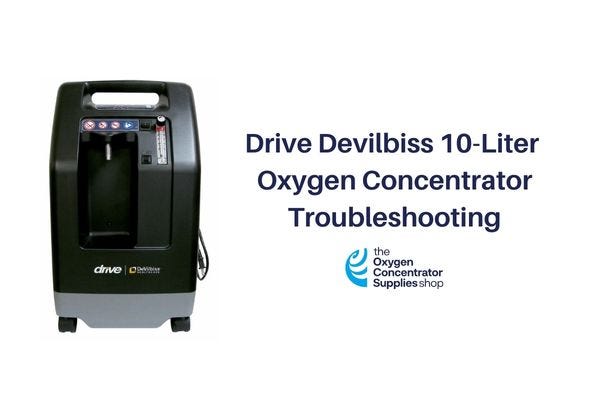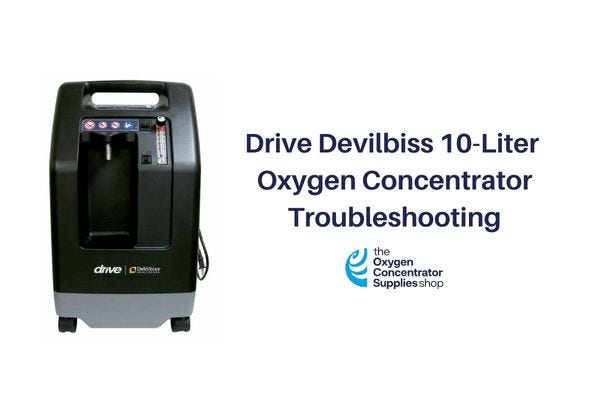

The DeVilbiss 10 Liter Oxygen Concentrator delivers a high volume of oxygen while weighing only 42 pounds. This is significantly lighter than other concentrators that produce this high volume. This unit can deliver 87%-96% oxygen purity ranging from 2 liters per minute (LPM) to 10 LPM.
Here are few tips for some potential troubleshooting problems.
Device Not Turning On
Situation 1: Power Cord Not Properly Inserted
If the unit does not operate and all lights are off when the power switch is turned on, then you need to look into the power source. Also. you may hear an audible alert in some instances. Commonly, the power cord is not properly inserted into the electrical outlet, causing a loss of power.
Solution
Check the power cord connection at the wall outlet. On 230-volt units, also check the mains connection on the back of the unit. A loose cord at the electrical outlet is easily resolved.
Situation 2: No Power at Wall Outlet
If the cord is plugged in properly and you still do not have power, likely, the outlet itself is not working.
Solution
You can try the oxygen concentrator at alternate outlets to determine if that is the problem. Also, check your home circuit breaker and reset it if necessary. Use a different wall outlet if the situation occurs again.
Situation 3: Activation of Oxygen Circuit Breaker
Sometimes power loss may require that the oxygen concentrator circuit breaker be activated.
Solution
Press the concentrator circuit breaker reset button located below the power switch. Use a different wall outlet if the situation occurs again. If the above remedies do not work, contact your Drive DeVilbiss provider.
Failure in Operation
Situation 1: Air Filter Has Been Blocked
A blocked air filter can cause the oxygen concentrator to not work properly. A red Service Required light may also be illuminated and an audible alert may be sounding. When the yellow Low Oxygen light is on and the intermittent audible signal is sounding may also be an indication of an air filter block.
Solution
Check the air filter. If the filter is dirty, wash it using the following cleaning instructions: use mild dish soap (2 tbsp) and warm water (2 cups) to clean the air filter every 7 days.
Situation 2: Exhaust Has Been Blocked
Sometimes other blockages may be causing the problem. A red Service Required light may be illuminated and an audible alert may be sounding if the exhaust is blocked. When the yellow Low Oxygen light is on and the intermittent audible signal is sounding it may also be an indication of an exhaust blockage.
Solution
Check the exhaust area and make sure nothing is restricting the unit exhaust. If the exhaust is too close to a wall or curtains it can cause a blockage. Make sure the area around the exhaust is always clear during operation.
Situation 3: Blockage or Defect in Face Mask, Cannula, Oxygen Tubing
The same red Service Required light may be illuminated and an audible alert may be sounding if blockages occur at the face mask, cannula, or oxygen tubing.
Solution
Detach cannula or face mask. If the proper flow is restored, clean or replace if necessary. Disconnect the oxygen tubing at the oxygen outlet. If the proper flow is restored, check the oxygen tubing for obstructions or kinks. Replace if necessary. Regular replacement of your mask, cannula, and tubing ensures the lasting performance of your oxygen concentrator. Always inspect these parts for wear.
Situation 4: Defect or Blockage in Humidifier Bottle
A defect or blockage in the humidifier bottle can also cause operation failure. Humidifier bottles can become defective over time or become blocked if not cleaned properly.
Solution
Detach the humidifier from the oxygen outlet. If the proper flow is obtained, clean or replace the humidifier. Follow cleaning procedures from the manufacturer for maintaining your humidifier bottle. Also, check for defects regularly and follow replacement schedules for humidifier bottles provided by the manufacturer.
Situation 5: Low Setting of Flow Meter
If you see that the yellow Low Oxygen light is on and the intermittent audible signal is sounding then the flow meter may not be set properly. Flow settings that are set too low can trigger a red flag for the oxygen concentrator and an alert will occur.
Solution
Set the flow meter to the prescribed flow rate. Ensure the flow meter is properly set to the prescribed number. (The maximum flow meter setting is 6 LPM when an oxygen bottle is being filled with oxygen from the auxiliary port.) If the above remedies do not work, contact your Drive DeVilbiss provider.
Low Sound Frequency
Situation 1: Malfunction in Electronic Assembly
The Drive Devilbiss 10 has an electronic system so it is subject to electronic malfunctions. Any failure in operation can be related to the electronic system.
Solution
Electronic failures are more serious and may not be easily resolved by troubleshooting. When they occur, contact your Drive DeVilbiss provider for support.
Yellow Low Oxygen Indicator Is On
Situation 1: Unit in “Start-Up” Mode
When the yellow low oxygen indicator is on, the oxygen concentrator may be in start-up mode. This is not a problem and is simply part of the start-up process.
Solution
Allow the unit up to 15 minutes to complete the start up period. After that period, your oxygen concentrator should be functioning properly.
The author is not affiliated in any way with DeVilbiss, so the suggestions of this product constitutes publicly-available information by DeVilbiss. Additionally, this post does not constitute medical advice in any way. It is recommended to discuss the specifics of any oxygen products with your doctor before ultimately purchasing a device to ensure you have the right equipment for your needs. This information is for educational purposes only.



